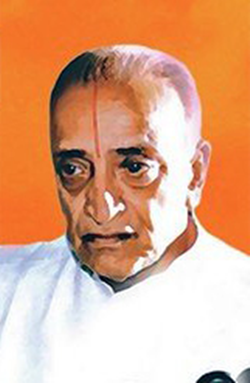Doraiswamy Iyengar was one of the finest Carnatic musicians and a veena maestro. His style of playing the veena is often referred to as the Mysore style. The Malleshwaram 13th Crossroad has been recently renamed in the honor of Padmabhushan awardee Shri V. Doraiswamy Iyengar.

Personal Life
Doraiswamy Iyengar was born into a family of renowned Carnatic musicians in 1920. His father Venkatesh Iyengar was a very well-known flutist and veena player. Apart from giving performances, he also taught members of the royal family how to play the flute. His early years were spent in the Gaddavalli village in Hassan district. He was married at the age of 12 years.
Iyengar’s introduction to playing music was with a mouth organ at the age of 4 years. His first guru was his father. When he surpassed his father, he became a disciple of veena maestro Venkatagiriyappa.
Doreswamy Iyengar passed away in October 1997. An academy was founded in his name to preserve the Mysore style.
Professional Performances
Iyengar started performing professionally at the age of 6 years. He was performing before the Maharaja of Mysore at the tender age of 12 years. The Maharaja was so impressed by the performance that he presented Iyengar with a sum of 50 silver rupees – a big sum in those days. He was later employed by the Mysore Palace as a court musician. At the age of 16 years, he became the youngest court musician.
He had a number of solo performances and also played along with violinists and vocalists. This includes Lalgudi G. Jayaraman, M.S. Gopalakrishnan, M. Balamuralikrishna and T.N. Krishnan. Some of the most well-known Hindustani artists he performed with were Amjad Ali Khan and Ali Akbar Khan.
Iyenger performed at a number of international events. He was a guest artist at the Persian Empire Millennium celebrations in 1969
Iyengar and the Radio
In 1955, Doreswamy Iyengar moved to Bangalore for the next step of his career. When the Mysore radio station merged with the All India Radio, Doreswamy Iyengar took on a new role as a producer. He worked with the radio for 25 years. During this time, he composed music for famous lyrics and orchestras and guided several young artists.
The Gita Bharati” was one of the unique features Doreswamy Iyengar put together for the radio. It brought together Thyagaraja and Muthuswami Dikshitar’s kritis with Rabindranath Tagore’s Bengali songs.
Doreswamy Iyengar’s Mysore Style
The Mysore style of playing the veena is very unique. Instead of using a metal ring, the nails of the right hand are used to play the veena in this style. This helps create a classical sound that is close to soft vocal tones.
Doreswamy Iyengar’s Felicitations
Iyenger was awarded an honorary doctorate in 1975 by the Univerity of Mysore. In 1985, he served as the President of All India Carnatic Music Conference and President of State Sangeeta Nritya Academy. He earned a number of awards during his lifetime. These are:
- The Central Sangeetha Natak Academy Award (1971)
- The Karnataka Nritya Academy Award (1971)
- The Sangeeta Kala Rathna of the Gayana Samaja, Bangalore (1976)
- The Padma Bhushan (1983)
- The Sangeeta Kalanidhi of the Madras Music Academy (1984)
- The Sangeeta Kalaratna of the Bangalore Gayana Samaj (1985)
- The Chowdiah National Memorial Award (1985)
- The Hafiz Ali Khan Award
- The Sangeeta Kala Sikhamani of the Indian Fine Arts Society (1994)